
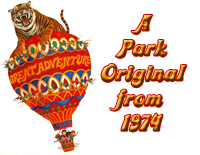
 Carousels are one of the oldest amusement park attractions, with spinning rides which were forerunners of today's rides dating back to 500 A.D., and more "modern" versions being introduced in the mid 1800's with the advent of steam power and later electric power at the turn of the 20th century. In England the earliest carousels (known as "gallopers") were constructed by farm machinery manufacturers. As the technology progressed, they became more elaborate with jumping figures and more ornate to attract the public's attention as part of traveling fairs. Eventually American craftsmen would elevate the carousel to the art form we know today, with more elaborate and larger machines designed for stationary locations in parks. |
 |
During the off-season, the figures are often taken off the Carousel and
brought into the park's Maintenance Shop where they are taken apart and
inspected. The wooden animals are repaired as necessary and the old paint is
stripped. New paint is hand applied in a multi-step process taking hours to
complete each figure. While all the figures are essentially identical, there is one "lead horse" which features an eagle on the left side beneath the saddle. Something rarely seen when the figures are in place on the Carousel is the fact that the left side of each horse is highly decorated with carved details and a ribbon, while the right side which faces inward is much simpler. Originally the ribbons on the horses would have featured the names of the children of the ride's owners or names of the carnival workers. The figures all feature glass eyes with one exception which was a replacement horse which has simple painted eyes instead. |
 |
||||||
 |
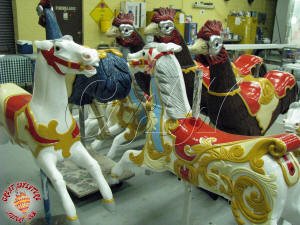 |
|||||||
 |
 |
 |
||||||
 |
 |
|||||||
 |
 |
 |
||||||
 |
 |
 |
||||||
 |
 |
|||||||
 |
The off-season is often a very busy time at the park, with rides like the
Carousel being taken apart for thorough inspection and regular maintenance.
The Carousel's portable past makes it fairly easy to take apart with all the
pieces being numbered for easy re-assembly. In the 2010-11 off season, the Carousel was taken apart completely as part of a long needed rehabilitation. The steam engine was removed and the gears at the heart of the ride's drive mechanism were thoroughly cleaned. The steam engine itself was brought into the Maintenance Shop with the hope to re-install it in some kind of working manor in the future. |
 |
||||||
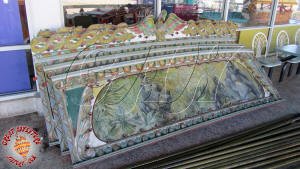 |
 |
|||||||
 |
 |
|||||||
 |
 |
 |
||||||
 |
 |
 |
||||||
 |
The Carousel's electric lighting system was long overdue for updating, so
the wiring was replaced throughout the panels. The lighting update brought
the Carousel from the he 19th century to the 21st with the addition of new
LED bulbs. Part of the challenge of working on such an old ride is the paint which was originally lead based. Any time that the paint is stripped for re-painting it requires special care for the workers to protect them from the dust created in the stripping process. |
 |
||||||
 |
 |
 |
||||||
 |
While the Carousel was apart for rehab, the figures were brought into the
Great Character Cafe for storage as well as for maintenance and touchups of
the paint. The process of rehabilitating the Carousel was more complex than anticipated, so not everything was ready to go back onto the ride for the 2011 season. The plaques which hung from the overhead sweeps were left off so they could be re-painted and re-wired properly. |
 |
||||||
 |
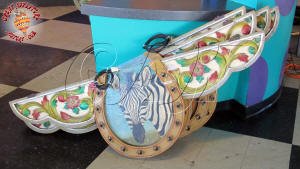 |
 |
||||||
 |
The deck of the Carousel was constructed with modular panels small enough to
be easily stowed in the travel trailers. All of the parts of the ride are
designed to take up as little space as possible when disassembled but create
a strong structure when full assembled. The iron rods that suspend the
wooden framework of sweeps from the central support column were relatively
light yet strong enough to support the weight of the machinery, figures,
platform and the riders.  The central column was designed with decorative panels to hide the machinery at the ride's heart as well as to add visual interest with additional lights and mirrors. One of the most striking features of any carousel is the ride's rounding boards. Great Adventure's Carousel featured rounding boards decorated with scenes of exotic animals of all kinds. While many guests assume it was painted by Great Adventure, the animal paintings predate the park's purchase of the ride and were painted while it was still owned by Jimmy Williams. |
 |
||||||
 |
 |
|||||||
 |
 |
|||||||
 |
 |
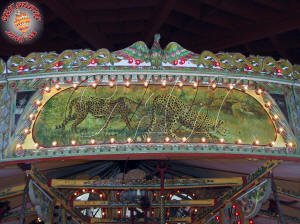 |
||||||
 |
 |
 |
||||||
 |
 |
 |
||||||
 |
 |
 |
||||||
 |
 |
 |
||||||
 |
Along with the decorative panels mounted around the inside of the deck of
the Carousel, the ride also features a decorative "crown" above which also
features panels of mirrors and lights adding to the visual spectacle as well
as hiding the internal gears and machinery that turns the crank shafts which
raise and lower the figures.   One of the unique features of an English style carousel is the open framework overhead. The spider web of wooden beams that support the crankshafts and figures are chamfered, helping to reduce the weight of the beams and making them more decorative. Chamfering of wooden beams was common in construction of old wagons as a way of reducing the weight of a beam while maintaining strength. At the time of construction, people marveled at the mechanical aspects of the ride, so the crankshafts were painted red to highlight them against the canvas roof, and the beams were given a very elaborate paint scheme as well to help show off the delicacy of the design.   In 1988 the biggest changes in the history of the Carousel took place with the steps being removed to increase safety as well as allowing easier access for children and the handicapped. A new concrete platform was constructed just below the wooden platform and ramps now lead up and down. With the steps gone, the rounding boards were too low over the concrete platform, so the ring of decorative trim and mirrors below the scenic panels was cut off, allowing more headroom. New taller iron fences reduced the chances for guests climbing over them while the ride was in motion. The original fences at ground level were low and easily climbed over. This was also when the Carousel was retrofit with an electric drive motor. Eventually the ride was setup with a single attendant/operator position and mirrors positioned to allow better viewing of the ride in motion. |
 |
||||||
 |
 |
|||||||
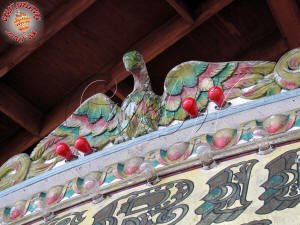 |
 |
|||||||
 |
 |
|||||||
 |
||||||||
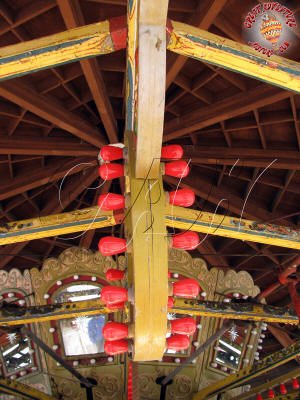 |
 |
|||||||
 |
 |
|||||||
 |
||||||||
 |
 |
 |
||||||
|
Carousel Features Removed Over the Years  |
||||||||
 |
 |
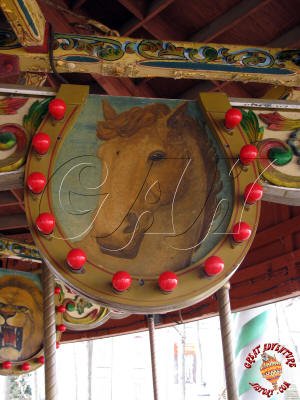 |
||||||
 |
 |
 |
||||||
 |
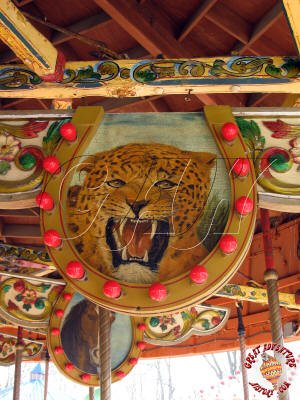 |
 |
||||||
 |
 |
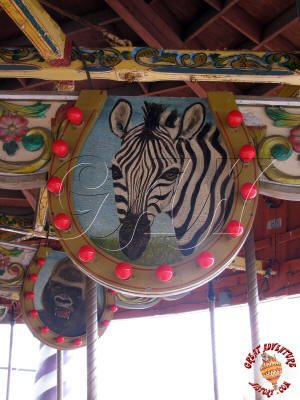 |
||||||
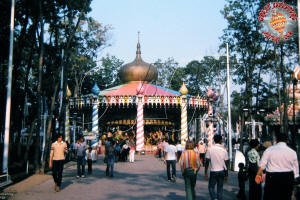 |
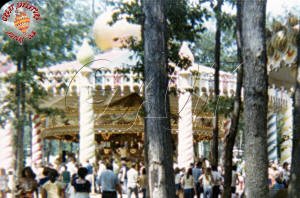 |
 |
||||||
 |
The pavilion that the Carousel stands in has seen
several cosmetic changes over the seasons. The bright colors of the roof and
columns were changed when Warner LeRoy sold the park as part of the
conditions of the sale. Many of the most elaborately and brightly painted
structures in the park were toned down. For one season the domes and decorative panels were painted pure
white along with the Yum Yum Palace. Other changes included removing the large central onion dome replacing it with a small louvered cupola. The outer domes were also removed and replaced with stylized clown faces above each of the columns. |
 |
||||||
 |
 |
|||||||
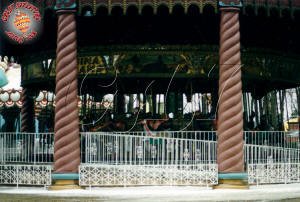 |
 |
|||||||
 |
 |
 |
||||||
 |
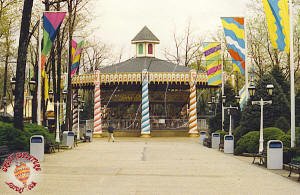 |
|||||||
 |
The paint colors of the pavilion continued to evolve over the years going from a stark brown with green accents back to a more colorful version with white as the primary color and each of the columns painted in a bright, cheerful color. The louvers on the cupola were painted in the same colors as well as the diamond shapes on the ends of the roof sections that had originally been mirrors. In later years the clown faces were removed and the small onion domes were re-attached. |
 |
||||||
 |
||||||||
 |
 |
 |
||||||
 |
 |
 |
||||||
 |
 |
 |
||||||
 |
The Carousel and its pavilion were to have undergone a three year restoration from 2008 through 2011, but plans changed with changes in management and priorities so no work was done in the 2009-2010 off season. The work restarted in the 2010-11 off season with the re-wiring and work on the steam engine, and hopefully the pavilion will get a much needed repainting and refreshing for the 2012 season along with additional work on the Carousel itself. |
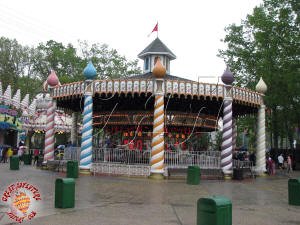 |
||||||
 |
||||||||
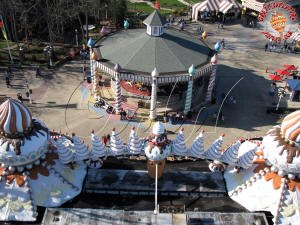 |
 |
 |
||||||
 |
 |
 |
||||||
 |
 |
 |
||||||
 |
Day or night, the Carousel is one of the most striking features of Great Adventure. The hundreds of lights that adorn the ride and the pavilion really make it spectacular after dark. The recent work on updating the electrical system and conversion to LED bulbs should make the Carousel continue to shine for another hundred years and thousands of riders yet to come. |
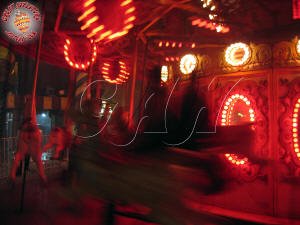 |
||||||
 |
 |
|||||||
 |
 |
 |
||||||
 |
 |
 |
||||||
 |
 |
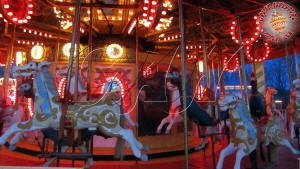 |
||||||
| Carousel Merchandise | ||||||||
 |
 |
 |
||||||
 |
 |
 |
||||||
 |
 |
 |
||||||
 |
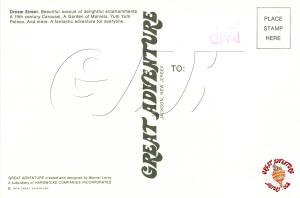 |
 |
||||||
 |
 |
 |
||||||
 |
 |
 |
||||||
|
||||||||